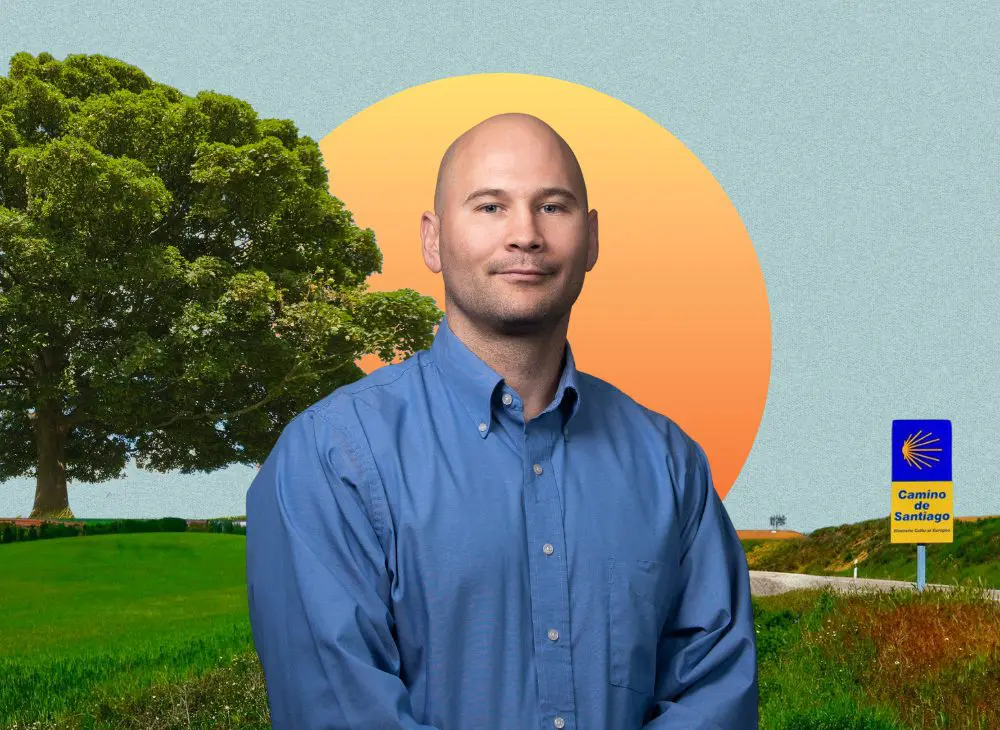“Like anything in human history, suicide is a story. It is a story we are told and tell ourselves. That we invest belief in or try to fulfill.” For Seth Allard, this understanding—that stories can heal or harm—drives his mission to transform how we approach mental health in veteran and Native American communities.
As both an Ojibwa person and a Marine Corps veteran, Allard brings a unique perspective to this work. In Native American culture, he explains, “Being a ‘Warrior’ or a ‘Protector’ takes on a much more nuanced and expansive role. People who serve the community, in uniform or not, are often called ‘Ogichidaa’ or Warrior. Elders, teachers, advocates, and people who stand up for others’ rights are prime examples of Ogichidaa.”
Now, as a scholars with HPRS and a PhD candidate in Social Work and Anthropology at Wayne State University, Allard is working to expand how we understand and prevent suicide.
“Our oral traditions, teachings, and ceremonies contain very powerful and eloquent models for how to think about topics like mental health, suffering, joy, community, emotions, and even suicide in a way that ties in with a greater sense of spirituality and identity. What’s more, our culture is not static, and youth can certainly carry these teachings so they reverberate with modern contexts in adaptive and enriching ways.”
Raised in rural Michigan, Seth’s love of storytelling evolved into what he calls “emancipatory writing”—work that explores the complexities of mental health through Indigenous knowledge and lived experience. Using poetry, autoethnography, and other creative forms, he develops deeper ways of understanding and sharing these experiences. “Our teachings are developmental,” Allard explains. “Sometimes, you need a story to make you stop and think ten years later.”
Challenging Traditional Research Models
“Academia doesn’t have ownership over aspects of the human condition,” Allard asserts. “They just have ownership over the words they create to describe it.” This insight drives his research methodology, which combines creative ethnographic writing, deep partnerships with community, and traditional Ojibwa teachings.
“I am taking even more of a turn towards literary methods and what I recently encountered through the writings of a fellow Anishinaabe Gerald Vizenor, as ‘writing in the oral tradition.’ Collectively, the act of storying helps me to connect to various audiences within the Military/Veteran community and Native American community, not only by touching on shared experiences or perspectives but by using narrative methods to activate specific emotional parts.”
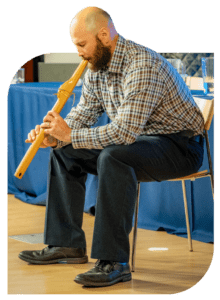
Seth Allard playing a Bibigwan at Summer Institute in Baltimore.
A key aspect of Seth’s work is community-based participatory research (CBPR), where the community directs the research’s focus and goals. Reflecting on his collaborations with Native and veteran communities, he shares, “The community has always had the answers. They possess the knowledge, the traditions, and the strategies to address these issues—they just need the resources to bring these solutions to life.” This approach mirrors his belief in the “servant intellectual,” where the researcher amplifies the community’s voice rather than imposing academic frameworks onto it.
Seth’s research challenges institutional barriers by advocating for cultural solutions to cultural problems. “Culture is a process of looking into the mirror at your individual and what I think of as the connective self. What each person sees will differ, but what remains the same is that we all must look into that mirror.”
His work emphasizes that effective mental health interventions must emerge within communities. “Native Americans must connect, engage with, and more consistently support a culture that exists, while the military must acknowledge the omnipresence of culture throughout the suicide prevention process,” he says.
“If the state of mental health in the community gets to the point that you need an enforceable policy or law to prevent youth suicide or military suicide, then deep systemic issues have occurred over a long period of time,” he observes. “The very foundations of the systems involved must be scrutinized.”
Seth’s research is grounded in making an impact. He shares, “I often return to what Jessica Harrington [Director of Scholar and Alumni Leadership Development at HPRS] said early in the program – “Policy without people becomes politics.” In that sense, how do I write to the people? I touch on their stories, neither agreeing nor disagreeing with them, but trying to meet people on the edges of where we are at and where we could be.”
Bridging Veteran and Indigenous Perspectives
In discussing health equity for veterans, Allard draws attention to systemic shortcomings within the military transition assistance program. Instead of one-off solutions, he advocates for “watershed strategies”—actions that address root causes and create cascading positive effects. These might include establishing policies that embed veteran voices in research and intervention initiatives or supporting veterans interested in mental health professions to pursue clinical and leadership roles.
His critique extends beyond individual programs to broader systemic issues. “Of course, there are larger social justice issues at play that may not be included within traditional policy approaches,” he notes. “A big example of this is the fact that we have been deploying servicemembers to illegal wars and directed our military to support illegal wars, which has had a heavy, existential impact on members of the military and veterans.”
This understanding informs his critique of how veterans’ mental health challenges are framed and treated. “I believe that the overuse of PTSD, rather than the appropriate use, or co-use, of moral injury, has political implications.” This distinction is crucial—while PTSD focuses on individual trauma responses, moral injury acknowledges the deeper ethical wounds that can occur when service members are placed in morally compromising situations.
“We need to step away from a primarily medical model of suicide driven by an industrial agenda and invest in cultural infrastructure and community strengths. Recently, an Alaska Tribal suicide prevention initiative led by Indigenous researchers and community members focusing on cultural strengths started being developed for use on local Army installations. This is a prime example of a strengths and community-based approach, rather than the risk or deficit-based approach that characterizes mainstream suicide prevention and research.”
His work with America’s Warrior Partnership’s Operation Deep Dive project exemplifies this more comprehensive approach. Rather than conducting traditional psychological autopsies of suicide cases, the project performs what Allard calls “Sociological Death analysis”—examining the broader social and network factors in the last 12 months of a person’s life.
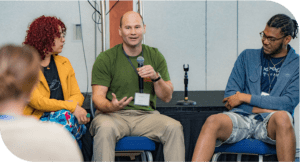
Seth speaking in a break out discussion after the Talanoa during Summer Institute in Baltimore.
“The overuse of quantitative methods, often led by researchers with little or no connection to Tribal or military communities, means that the key issues at play within communities and institutions involved in suicide prevention are left out of the results,” Allard explains. “By taking great care to listen to military personnel, veterans, and Native Americans, you can receive very rich descriptions of problems, solutions, and perspectives on suicide that can be translated into policy.”
This systems-level understanding shapes his approach to both veteran and Indigenous mental health. “On the face of it, these types of policy changes do not seem to be relevant to suicide,” he reflects, “but that is the thing about highly complex, interconnected phenomena—pulling the string that you think will undo the knot makes it worse, and working on the strings that seem irrelevant to people without a cultural, systems approach will eventually unravel the knot.”
This perspective extends to his work with Native communities as well. “The Native American community must come into its own, without over-relying on outside resources or insincere ideas of restorative justice,” he asserts. “We cannot wait for anyone to acknowledge our dignity or empower us.”
“Every Native American veteran and every Native youth deserves to feel seen and understood in their struggles,” Seth reflects. “Honoring both Native knowledge and veteran identity is the foundation for creating mental health systems that do just that.”
Learning Through Journey
For Seth, research must go beyond traditional academic methods to understand deeper truths. This led him to undertake a month-long pilgrimage on the Camino de Santiago with his eleven-year-old son. “I wanted to understand from my background—I come religiously from a mixed Catholic and Ojibwe background,” he explains. His grandmother, a boarding school survivor and self-described French Catholic, inspired his journey to explore these intersecting and juxtaposed identities, some brought on by forced assimilation and others held deep. Like the communities he works with, these identities carry both struggle and strength.
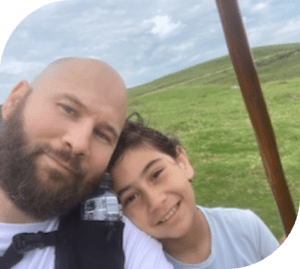
Seth with his son Liam walking the Camino de Santiago in Spain.
“Walking the Camino de Santiago with my son was an attempt to connect all these parts of myself—the researcher, the veteran, the father, the Native man.” This pilgrimage became a metaphor for Seth’s work: a journey of integrating his identities and finding unity among them, a path he hopes will inspire future generations to carry forward.
Among pilgrims from different countries struggling to communicate, he discovered profound truths about human connection. “Through the inability to speak perfectly in each other’s languages and dialects, what you end up coming up with is a more authentic version of what you mean,” he reflects. “You have to take off the filter. Because of those filters, you’re trying to speak, and the only way to speak to each other is through the broken language that you have.”
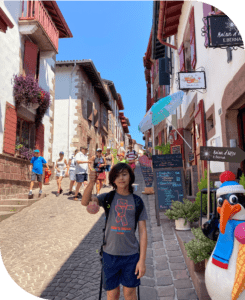
Seth’s son Liam on the Camino de Santiago.
This insight was reinforced by a conversation in an ornate Spanish church with a fellow pilgrim, Pascal, who observed the elaborate religious artwork: “This is someone else’s story.” For Allard, this crystallized how different communities can maintain their truths while engaging in dialogue with others—a principle that guides his approach to mental health research and healing.
Perhaps the most profound insight came from his young son, who stated during one of their breaks: “Everybody’s a story.” This child’s wisdom encapsulates Allard’s approach to research and healing—understanding that each person’s experience contains its truth and power.
Finding Community in HPRS
Through the HPRS program, Allard has found a community that supports his unconventional approach. “HPRS goes well beyond doctoral training,” he reflects. “What I needed was to build a sense of belief in change, and a place within community that valued my way of thinking and exposed me to a rich field of thought and experience.”
The power of this support became clear during an early check-in with HPRS Director Keshia Pollack Porter. Between shifts at his VA social work placement, Allard shared his feelings of isolation. Her response transformed his understanding of what support could look like: “

Seth with fellow HPRS scholars in Baltimore during Summer Institute
Seth, we’re here for you. Not because of your university, your advisor, or the VA. We chose you because of you.”
“I almost broke down right there,” Allard recalls.
“I cannot begin to describe the impact that HPRS has had on me… I remember the first day walking into Fall Institute, and everyone kind of drew a palpable sigh of relief. Yes, we are all very different, which is kind of the point, but what we had in common, among many things, was a critical mindset, a dedication to the health of our communities, and a need for community support, peer mentorship, and mentorship from the wonderful people at HPRS.”
Creating Lasting Change
His work draws on the Ojibwe teaching of Seven Generations—the idea that our actions today should benefit children seven generations into the future. “Oftentimes, the significance of our work is not realized until after we Walk On,” he reflects. “I am not dedicated to appeasing an academic discourse in the now, but to furthering a vibrant, growing Indigeneity long into the future.”
As we commemorate both Native American Heritage Month and Veterans Day, Allard emphasizes the need for Native veterans to “organize, find one another, and celebrate our unique identity. We embody both a military ethos and a distinct, powerful set of cultural beliefs and connections. We are more than statistics, risk factors, or the often-negative stereotypes that are pervasive within popular culture and reproduced within academic and health science discourse.”
At a recent book event, fellow veteran Colonel Gregory Gadsen offered advice that captures the spirit of Allard’s mission: “Write something that your grandkids can pick up and be proud of. Tell the truth, and don’t hold anything back.”
Through his research and dedication to community-led solutions, Allard embodies how HPRS scholars are working to build health systems that serve everyone. His work shows that by honoring diverse ways of knowing and healing, we can create mental health systems that truly support the well-being of all communities.

